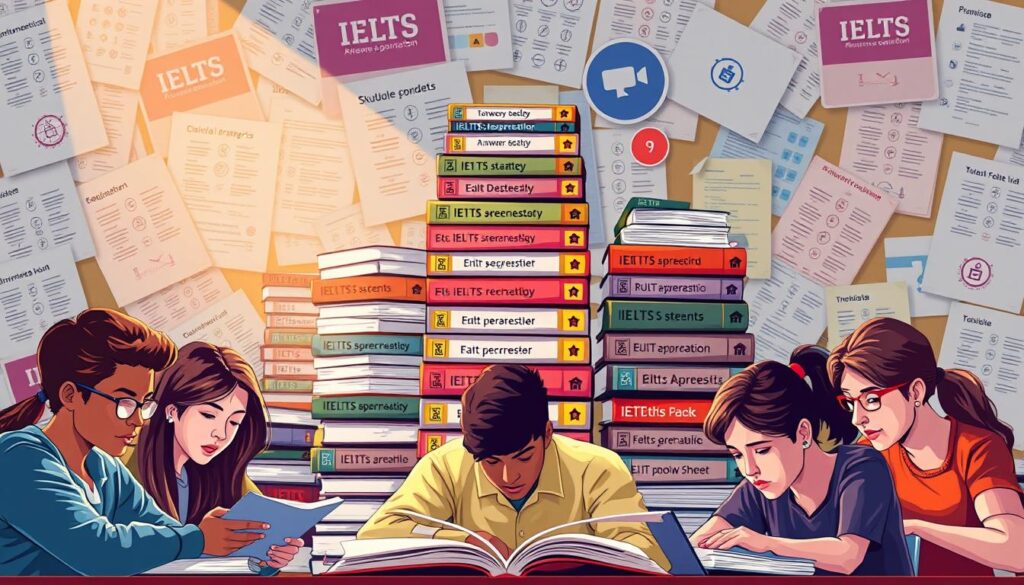The IELTS writing test is a crucial part of the IELTS exam, assessing your ability to communicate effectively in English. A strong performance in the writing section can significantly boost your overall score, making it essential to approach this task with careful preparation and strategy.
Understanding the marking criteria is the first step toward achieving success. The exam evaluates your ability to present ideas clearly, organize thoughts logically, and use vocabulary appropriately. Many test-takers find it challenging to manage their time effectively, as the writing section has a strict 60-minute limit for both tasks combined.
Expert tips suggest that practicing with sample essays and seeking feedback can greatly improve your writing skills. Additionally, expanding your vocabulary and avoiding common grammatical errors are key strategies to enhance your performance. Staying focused during the test and maintaining a clear structure in your essays can also lead to better scores.
Key Takeaways
- Understand the IELTS writing marking criteria to align your approach with examiner expectations.
- Plan your time effectively to complete both writing tasks within the 60-minute limit.
- Practice with sample essays to gain insights into the required structure and language use.
- Expand your vocabulary to convey ideas more effectively.
- Seek feedback from instructors to identify and correct common mistakes.
By following these expert tips and dedicating time to practice, you can significantly improve your IELTS writing skills and achieve a higher score. Stay focused, maintain a clear structure, and express your ideas confidently to excel in this critical section of the exam.
Understanding the IELTS Writing Test Format
The IELTS writing section is divided into two tasks, each designed to assess different skills. For both Academic and General Training tests, candidates have 60 minutes to complete both tasks.
Overview of Test Components and Timing
Academic test takers complete Task 1 by describing visual data, while General Training candidates write a letter. Task 2 requires an essay response to a given essay question. Task 2 is more heavily weighted, contributing 2/3 of the writing score.
Allocating 20 minutes for Task 1 and 40 minutes for Task 2 is recommended. Planning and proofreading are crucial for optimal performance.
Marking Criteria Explained
The marking criteria include Task Response, Coherence and Cohesion, Lexical Resource, and Grammatical Range and Accuracy. Each criterion contributes equally to the final score.
A Band 9 requires a comprehensive, well-structured response with precise vocabulary and grammar. Regular practice with sample essays can help improve performance.
Discover more strategiesto enhance your writing skills and achieve a higher score.
how to ielts writing: Strategies for Success
Mastering the IELTS writing section requires a strategic approach. To achieve a high score, it’s essential to understand the test format and develop effective writing techniques. This section will guide you through proven strategies to excel in your writing tasks.
Breaking Down the Essay Question
A strong essay begins with a clear understanding of the question. To fully address every part, identify the key components and plan your response. Start by brainstorming ideas and organizing them into well-structured paragraphs. Using varied sentence structures and precise language will enhance the clarity of your writing.
Key Insights for Achieving Higher Band Scores
Understanding how band scores are awarded is crucial. A high score depends on your ability to present ideas clearly, use appropriate vocabulary, and maintain grammatical accuracy. Focus on developing each paragraph with supporting examples and linking words to ensure coherence and cohesion.
Practicing with sample essays and seeking feedback can significantly improve your writing skills. Pay attention to sentence structure and language use, as these are critical factors in achieving a high band score. By following these strategies, you can enhance your performance and confidently approach the writing tasks.
Planning and Time Management for Your Writing Tasks
Effective time management is the cornerstone of success in the IELTS writing section. With only 60 minutes to complete both tasks, every second counts. A well-structured plan ensures you can present your ideas clearly and achieve a high score.
Allocating Time to Read, Write, and Proofread
A proven strategy is to divide your time into three parts: reading, writing, and proofreading. Allocate 5-10 minutes to read the question carefully, 15-20 minutes to draft your essay, and 10 minutes for proofreading. This approach ensures you cover all aspects without rushing.
Establishing a Personal Writing Schedule
Creating a personal schedule helps maintain consistency. Set aside dedicated time each day to practice writing under exam conditions. This habit builds familiarity with the test format and improves your speed and accuracy.
| Activity | Recommended Time | Details |
|---|---|---|
| Reading and Planning | 5-10 minutes | Understand the question, brainstorm ideas, and outline your essay structure. |
| Writing | 15-20 minutes | Develop your introduction, body paragraphs, and conclusion. Use linking words for coherence. |
| Proofreading | 10 minutes | Check for grammatical errors, improve sentence flow, and ensure all parts of the question are addressed. |
By following this structured approach, you can enhance your score outcomes. Remember, consistent practice and adherence to time limits are key to achieving a higher band score. For more strategies, visit expert resources to refine your skills.
“Time management is not just about tracking minutes; it’s about making every second count towards your goals.”
Analyzing the Essay Question and Identifying Key Issues
Understanding the essay question is the first step to delivering a strong response. Many candidates lose marks because they fail to address all parts of the question. Taking the time to carefully read and analyze the question ensures that your answer stays on topic and meets the examiner’s expectations.
Importance of Reading Carefully
Reading the question carefully is essential for identifying the key issues. For example, if the question asks you to discuss both views and give your opinion, make sure you address both perspectives. A common mistake is to focus on only one part of the question, which can result in a lower score.
Always look for instruction words like “discuss,” “describe,” or “explain.” These words tell you what the examiner is looking for. For instance, a question that asks you to discuss the advantages and disadvantages of something requires a balanced approach.
Highlighting and Addressing Multiple Issues
Once you’ve identified the key issues, highlight them and plan your response. For example, if the question asks about the causes and solutions of a problem, make sure you cover both. Use specific examples to support your points, and organize your essay into clear paragraphs.
By addressing all parts of the question, you demonstrate a complete understanding of the topic. This approach not only improves your Task Response score but also shows that you can think critically and present your ideas clearly.
Outlining Your Response: Creating a Blueprint
Creating a detailed outline is essential for producing a well-structured essay. This blueprint serves as a roadmap, guiding you through the writing process and ensuring your ideas are presented logically. A clear outline helps maintain coherence and cohesion, which are critical for achieving a high band score.
Structuring Your Essay: Introduction, Body, Conclusion
Your essay should be divided into three main sections: introduction, body paragraphs, and conclusion. The introduction sets the stage by presenting your thesis statement and outlining your opinion. Body paragraphs provide evidence and examples to support your stance, while the conclusion summarizes your main points and reinforces your thesis.
A strong introduction grabs the reader’s attention and clearly states your position. In the body, each paragraph should focus on a single idea, supported by relevant examples and linking words. The conclusion ties everything together, leaving a lasting impression on the examiner.
For example, if the essay question asks about the benefits and drawbacks of social media, your outline might look like this:
- Introduction: Present the topic and your opinion on its impact.
- Body Paragraph 1: Discuss the advantages of social media.
- Body Paragraph 2: Explore the disadvantages.
- Conclusion: Summarize your points and restate your opinion.
A well-structured outline ensures your essay flows smoothly and covers all parts of the question. This not only improves your Task Response score but also demonstrates your ability to organize ideas effectively. By following this blueprint, you can produce a coherent and compelling essay that meets the examiner’s expectations.
Crafting a Strong Introduction and Thesis Statement
A well-crafted introduction is the foundation of a successful essay. It sets the tone and provides readers with a roadmap of your argument. A strong introduction captivates the reader and clearly presents your thesis statement, which guides the rest of your essay.
Setting the Stage with a Captivating Opening
The opening sentence should grab attention while providing context. For example, “The increasing popularity of social media has sparked debates about its impact on society.” This sentence introduces the topic and leads into your thesis. The thesis statement should be clear and specific, such as, “While social media offers opportunities for global connectivity, it also poses significant privacy concerns.”
Avoid generic statements like “Social media is a double-edged sword.” Instead, use specific language to outline your argument. Your introduction should be concise, ideally 40-50 words, and avoid introducing new ideas that won’t be explored in the essay.
Reviewing your introduction after writing the essay ensures alignment with your arguments. A strong thesis statement improves clarity and coherence, crucial for achieving a high band score.
Developing Body Paragraphs with Coherence and Cohesion
Crafting body paragraphs is central to a well-structured essay. These paragraphs form the backbone of your argument, presenting evidence and examples that support your thesis. To achieve coherence and cohesion, each body paragraph must focus on a single main idea, with clear topic sentences and logical connections between sentences.
Using Linking Words and Phrases Effectively
Linking words and phrases are essential for creating a smooth flow between ideas. Words like “however,” “moreover,” and “in conclusion” guide the reader through your argument. For example, using “on the one hand” and “on the other hand” helps present balanced viewpoints. These devices ensure your essay is not just a collection of ideas but a unified, logical presentation.
Organizing Ideas and Supporting Examples
A well-organized body paragraph starts with a clear topic sentence. This sentence outlines the main idea, which is then supported by examples and explanations. For instance, if discussing the benefits of social media, you might write, “Social media platforms, such as Facebook, offer opportunities for global connectivity.” This approach ensures each paragraph is focused and contributes to the overall essay structure.
By structuring your body paragraphs with coherence and cohesion, you enhance the clarity and persuasiveness of your essay. Using linking devices and supporting examples effectively will help you achieve a higher band score and communicate your ideas with confidence.
Editing, Proofreading, and Finalizing Your Essay
Editing and proofreading are crucial steps in the IELTS test preparation process. These steps ensure your essay is polished and free from errors, which can significantly impact your score.
Strategies to Spot and Correct Errors
A comprehensive editing strategy involves several key steps. Start by reading your essay silently to identify grammatical and spelling errors. Then, read it aloud to catch awkward phrasing or unclear sentences. Using a checklist can help you systematically review each part of your essay, ensuring nothing is overlooked.
- Review for grammatical and spelling errors.
- Check sentence structure and flow.
- Ensure all parts of the question are addressed.
Importance of a Second Proofread
A second review is essential for catching issues you might have missed the first time. This step helps refine word usage and structure, ensuring your essay is as strong as possible. Staying calm and methodically checking each paragraph can make a big difference in the quality of your final submission.
By following these steps, you can ensure your essay is well-prepared and error-free, giving you the best chance to achieve a high score in the IELTS test.
Expert Tips and Resources for IELTS Writing Success
Reaching a high score in the IELTS writing section requires more than just practice—it demands the right strategy and resources. With so many options available, it can be overwhelming to decide where to start. This section will guide you through the best tools and expert advice to help you excel.
Utilizing Model Essays and Practice Tests
Model essays are a goldmine for understanding what examiners expect. They provide real-life examples of high-scoring responses, helping you learn structure, vocabulary, and coherence. Practice tests, on the other hand, allow you to simulate exam conditions, ensuring you’re comfortable with the time limits and question formats.
Video lessons are another valuable resource. They offer step-by-step guidance on tackling different essay types, from opinion essays to problem-solution essays. By studying these materials, you can identify patterns and refine your writing skills effectively.
Tools and Webinars for Further Preparation
Webinars conducted by IELTS experts can offer personalized tips and insights. These sessions often cover common mistakes, scoring criteria, and strategies to improve your performance. Official IELTS preparation courses are also an excellent choice, as they provide structured learning paths tailored to your needs.
Tools like vocabulary builders and essay checkers can streamline your study plan. These resources help you track progress, identify weak areas, and focus on improvement. Regular practice with high-quality materials is key to achieving a higher band score.
By leveraging these resources and maintaining consistent practice, you can significantly enhance your writing abilities and confidence. Remember, success in the IELTS writing section is about understanding the expectations and delivering a well-structured, clear response.
Conclusion
In conclusion, achieving success in the IELTS writing section requires careful planning and a strategic approach. By summarizing key strategies and techniques, such as proper planning and outline development, you can enhance your performance. Utilizing expert resources and model essays provides continuous improvement opportunities, helping you address a range of issues effectively.
Embrace a structured approach to tackle different types of essay questions, ensuring each response is well-organized and coherent. This method not only helps in identifying problems but also offers solutions, leading to a polished and impactful essay. Remember, consistent practice with high-quality materials is key to achieving a higher score.
Take the next step by exploring free webinars and practice materials to refine your skills further. With dedication and the right resources, you can master the IELTS writing section and achieve your goals with confidence.
FAQ
What is the IELTS writing test format?
The IELTS writing test includes two tasks. Task 1 involves describing a graph, chart, or process, while Task 2 requires writing a discursive essay on a given topic. Each task is designed to assess your ability to organize ideas and use English effectively.
How can I improve my band score?
Focus on understanding the marking criteria, such as task response, coherence and cohesion, lexical resource, and grammatical range and accuracy. Practice with model essays and seek feedback to refine your skills.
What are the key strategies for success in IELTS writing?
Start by understanding the essay question thoroughly. Plan your response with a clear introduction, body, and conclusion. Use linking words to ensure coherence, and provide relevant examples to support your points. Always proofread your work to catch errors.
How should I allocate my time during the test?
Allocate 20 minutes for Task 1 and 40 minutes for Task 2. Spend 5 minutes planning, 15 minutes writing, and 5 minutes reviewing each task. This ensures you have enough time to complete both tasks effectively.
What is the importance of reading the essay question carefully?
Reading the question carefully ensures you address all parts of the task. Misreading can lead to a low score, as your response must be relevant to the question. Always highlight key words and phrases to stay focused.
How can I structure my essay effectively?
Begin with a strong introduction that includes a thesis statement. The body paragraphs should each focus on a single idea, supported by examples. Conclude by summarizing your main points and restating your thesis in different words.
What tools can help me prepare for the IELTS writing test?
Utilize official resources like the British Council’s study materials and Cambridge IELTS books. Online tools, such as grammar checkers and vocabulary apps, can also support your preparation. Joining webinars or writing groups can provide additional insights and feedback.











